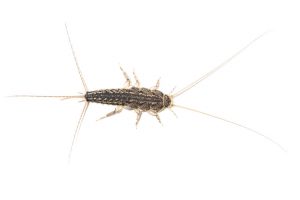Identification and Life Cycle
The Silverfish (Lepisma saccharina), and the Firebrat (Thermobia domestica), are closely related and both are common household pests. They can cause damage by eating foods and other materials that are high in protein, sugar, or starch.
The Silverfish are wingless insects. They are silver to brown in color with shiny silver or pearl gray fine scales covering its body. Adults are approximately 3/4 – inch in length (elongated and oval in shape), have three long tail projections and two antennae. They get their name because of their silvery light grey color and fish-like appearance. They can live and breed indoors in damp, cool locations such as basements.
The Firebrat are also wingless insects and are similar in size and appearance to the silverfish. They have three, tail-like projections protruding from their abdominal segment, two antennae (longer than their body), and are a mottled gray or tan in color with brown scales. They live and breed indoors in hot, dark areas such as around furnaces.
Silverfish and firebrats are able to live without food for several months. The develop slowly under normal household conditions and have a life span of 2 to 8 years. They lay eggs during any time of year in secluded areas such as behind books or on dark closet shelves. The female silverfish typically lays a few eggs at one time, and only about 50 eggs in her lifetime. They are oval shaped, whitish eggs that can take 19 to 43 days to hatch. Firebrats deposit approximately 50 eggs at one time, and hatch in 14 days or longer depending on its environment. Both reach maturity in 3 to 24 months.



Comments are closed.